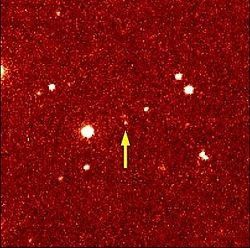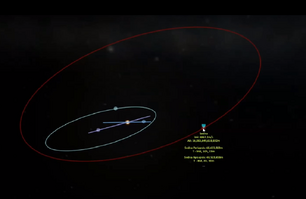Promethius20 (talk | contribs) No edit summary Tag: rte-wysiwyg |
Promethius20 (talk | contribs) No edit summary Tag: rte-wysiwyg |
||
| Line 1: | Line 1: | ||
| − | 90377 Sedna is a [http://en.wikipedia.org/wiki/Trans-Neptunian_object <u>trans-Neptunian object</u>] discovered in 2003, which currently lies about three times as far from the Sun as [[Neptune]] |
+ | 90377 Sedna is a [http://en.wikipedia.org/wiki/Trans-Neptunian_object <u>trans-Neptunian object</u>] discovered in 2003, which currently lies about three times as far from the Sun as [[Neptune]] This Dwarf planet is located in the outer Scattered disk region also known as the "Sednoidian asteroid belt" region of the Sol system. Its thought that the Dwarf planet Eris orbits a Brown dwarf star named Niburu and that Sedna orbits either a black star or a nuetron star named Nemesis, due to gravity purturbations being observed on the planet Neptune back in the year 1850 a few years after Neptunes discovery. These gravity purturbations of Neptune, Pluto ,Eris and now Sedna all clearly indicate that the Solar system is just a singal star system but the single star moved places over the billions of years. The findings indicate its always just been that mono-solar system that moved and a brown dwarf that never ignigted that purturbs the orbits of Neptune, Pluto , and Eris, and Sedna. But Sedna is also having its orbit being purturbed by another solar system object the theorized to exsit neutron star of Nemesis. |
| + | |||
| + | [[File:250px-NASA_Sedna.jpg|thumb|250px|A picture of Sedna]]Although Eris and Pluto on the other hand represent the other region of the outer solar system the Kuipler belt. and the Main region of the Solar system with its 8 planets and 1 dwarf planet Ceres is divided into 2 parts/sub-regions, the inner and the outer. The Main region of the solar system is also known by astro pysistists as the Heliopause. its the only place in the entire solar system not just Sol but the other systems such as Nibiru and Nemesis are theorized to exsit by gravity purturbations. |
||
==Characteristics== |
==Characteristics== |
||
Roughly two-thirds the size of [[Pluto]], Sedna is theoretically large enough to be rounded by its own gravity, and thus would qualify as a dwarf planet under current definitions. However, its distance from the Sun makes determining its shape difficult. Spectroscopy has revealed that Sedna's surface composition is similar to that of some other trans-Neptunian objects, being largely a mixture of water, methane and solid nitrogen with [http://en.wikipedia.org/wiki/Tholin <u>tholins</u>]. |
Roughly two-thirds the size of [[Pluto]], Sedna is theoretically large enough to be rounded by its own gravity, and thus would qualify as a dwarf planet under current definitions. However, its distance from the Sun makes determining its shape difficult. Spectroscopy has revealed that Sedna's surface composition is similar to that of some other trans-Neptunian objects, being largely a mixture of water, methane and solid nitrogen with [http://en.wikipedia.org/wiki/Tholin <u>tholins</u>]. |
||
Latest revision as of 04:19, 22 April 2016
90377 Sedna is a trans-Neptunian object discovered in 2003, which currently lies about three times as far from the Sun as Neptune This Dwarf planet is located in the outer Scattered disk region also known as the "Sednoidian asteroid belt" region of the Sol system. Its thought that the Dwarf planet Eris orbits a Brown dwarf star named Niburu and that Sedna orbits either a black star or a nuetron star named Nemesis, due to gravity purturbations being observed on the planet Neptune back in the year 1850 a few years after Neptunes discovery. These gravity purturbations of Neptune, Pluto ,Eris and now Sedna all clearly indicate that the Solar system is just a singal star system but the single star moved places over the billions of years. The findings indicate its always just been that mono-solar system that moved and a brown dwarf that never ignigted that purturbs the orbits of Neptune, Pluto , and Eris, and Sedna. But Sedna is also having its orbit being purturbed by another solar system object the theorized to exsit neutron star of Nemesis.

A picture of Sedna
Although Eris and Pluto on the other hand represent the other region of the outer solar system the Kuipler belt. and the Main region of the Solar system with its 8 planets and 1 dwarf planet Ceres is divided into 2 parts/sub-regions, the inner and the outer. The Main region of the solar system is also known by astro pysistists as the Heliopause. its the only place in the entire solar system not just Sol but the other systems such as Nibiru and Nemesis are theorized to exsit by gravity purturbations.
Characteristics[]
Roughly two-thirds the size of Pluto, Sedna is theoretically large enough to be rounded by its own gravity, and thus would qualify as a dwarf planet under current definitions. However, its distance from the Sun makes determining its shape difficult. Spectroscopy has revealed that Sedna's surface composition is similar to that of some other trans-Neptunian objects, being largely a mixture of water, methane and solid nitrogen with tholins.
Links[]

This map shows 4 worlds the Map is titled to show the Galactic plane Edge on for instance Neptune's orbit in center is relatively where the 8 main planters are including Earth and Neptune. Pluto and Eris are also shown for scale. Sedna is the red colored orbit.